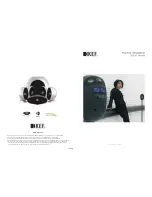
- 6 -
SAFETy AND WARNINGS
1. EnERgY STAR is a set of power-saving guidelines by the U.S. Environmental Protection Agency (EPA). EnERgY STAR is a
joint program of the U.S. Environmental Protection Agency and the U.S. department of Energy helping us all save money
and protect the environmental through energy efficient practices.
2. Read all instructions.
3. Keep these instructions.
4. Heed all warnings.
5. Follow all warnings.
6. do not use this apparatus near water.
7. Clean only with a dry cloth.
8. do not block any ventilation openings. Install in accordance with the manufacturer’s instructions.
9. do not install near any heat sources such as radiators, heat registers, stoves, or other apparatus (incl. amplifiers) that
produce heat.
10. do not defeat the safety purpose of the polarized or grounding-type plug. A polarized plug has two blades with one
wider than the other. A grounding type plug has two blades and a third grounding prong. The wide blade or the third
prong are provided for your safety. If the provided plug does not fit into your outlet, consult an electrician for replacement
of the obsolete outlet.
11. Protect the power cord from being walked on or pinched particularily at plugs, convenience receptacles, and the point
where they exit from the apparatus.
12. Only use attachments/accessories specified by the manufacturer.
13. Use only with cart, stand, tripod, bracket, or table specified by the manufacturer, or sold with the
apparatus. when a cart is used, use caution when moving the cart/apparatus combination to avoid
injury from tip-over.
14. Unplug this apparatus during lightning storms or when unused for long periods of time.
15. Refer all servicing to qualified service personnel. Servicing is required when the apparatus has been damaged in any
way, such as power-supply cord or plug is damaged. Liquid has been spilled or objects have fallen into the apparatus, the
apparatus has been exposed to rain or moisture, does not operate normally, or has been dropped.
16. Apparatus should not be exposed to dripping or splashing, and objects filled with liquids, such as vases, should
not be placed on the apparatus.
17. An outside antenna system should not be located in the vicinity of overhead power lines or other electric light or power
circuits, or where it can fall into such power lines or circuits. when installing an outside antenna system, extreme care
should be taken to keep from touching such power lines or circuits, as contact with them might be fatal.
18. do not overload wall outlets and extension cords, as this can result in a risk of fire or electric shock.
19. do not push objects through any openings in this unit, as they may touch dangerous voltage points or short out parts
that could result in fire or electric shock. never spill or spray any type of liquid into the unit.
20. If an outside antenna or cable system is connected to the unit, be sure the antenna or cable system is grounded to provide
some protection against voltage surges and built-up static charges, Section 810 of the national Electrical Code, AnSI/
nFPA 70, provides information with respect to proper grounding of the mast and supporting structure, grounding of the
lead-in wire to an antenna discharge unit, size of grounding conductors, location of antenna discharge unit, connection
to grounding electrodes, and requirements for the grounding electrode.
21. when replacement parts are required, be sure the service technician uses replacement parts specified by the manufacturer
or those that have the same characteristics as the original part. Unauthorized substitutions may result in fire, electric
shock or other hazards.
22. Upon completion of any service or repairs to this unit, ask the service technician to perform safety checks to determine
that the unit is in proper operating condition.







































